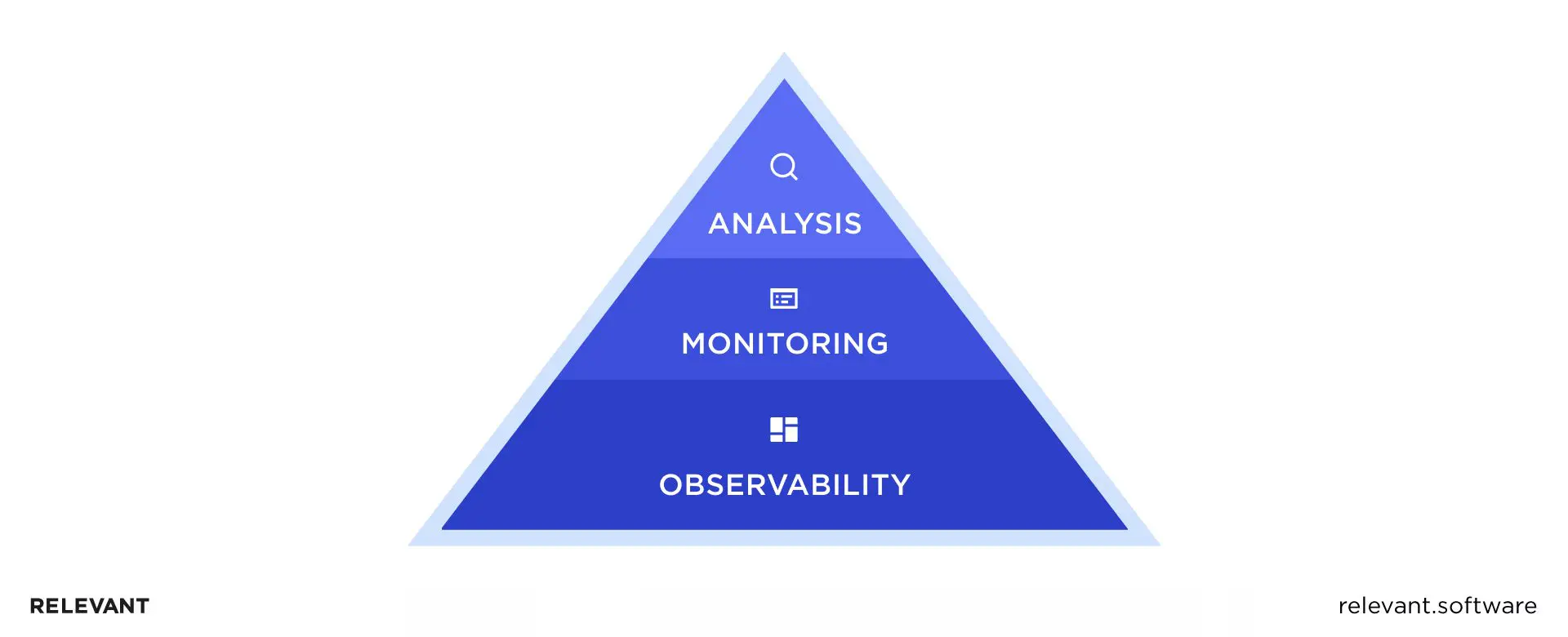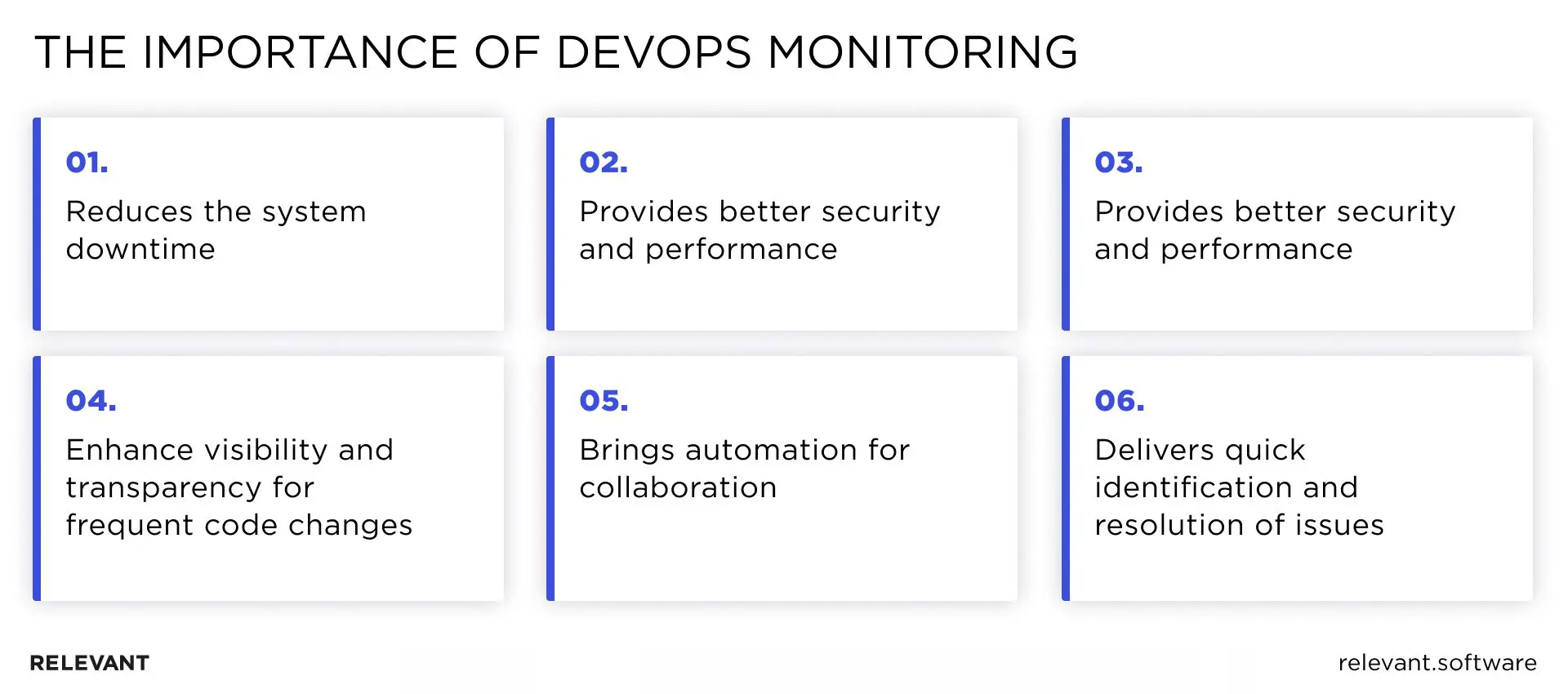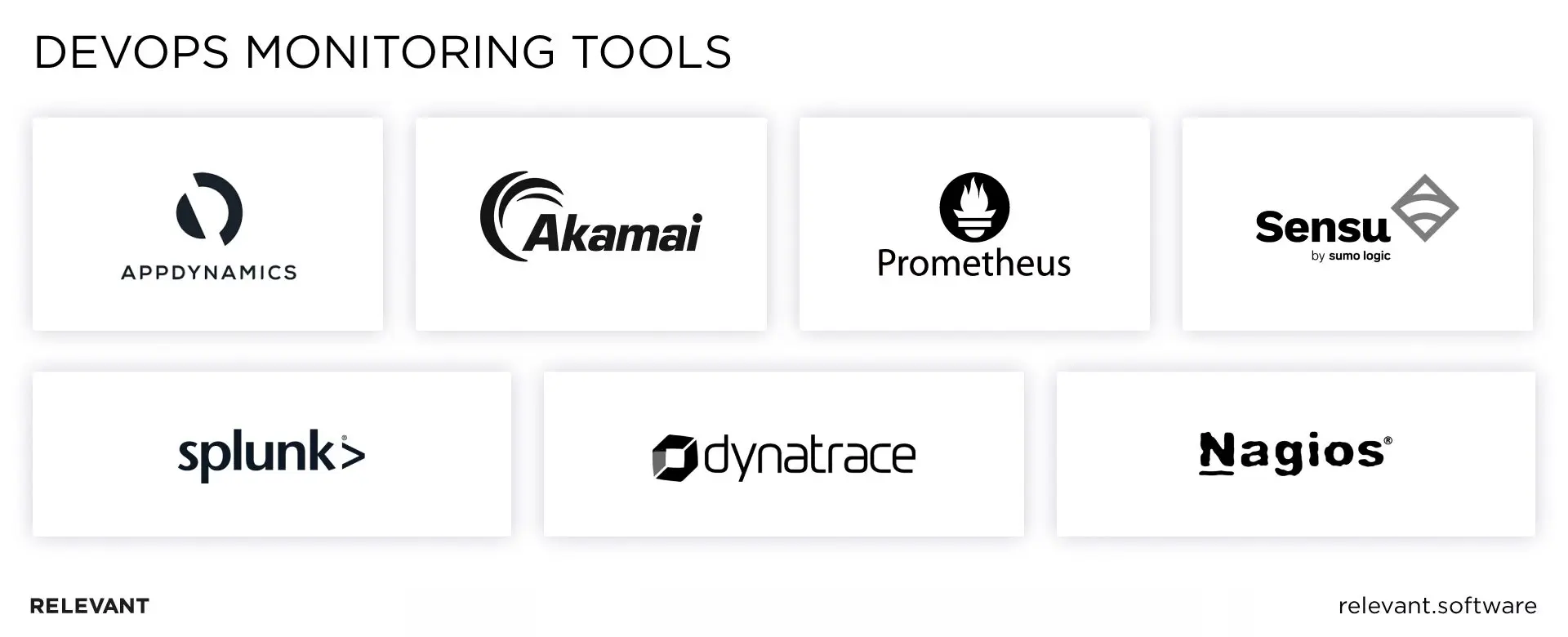DevOps Monitoring in 2023: Everything You Should Know

DevOps monitoring is crucial for making your DevOps process efficient. It is essential to have a way to track and manage the performance of your application, monitor your infrastructure, and make sure your DevOps automation is actually effective so you can identify issues quickly and fix them before they become major problems. DevOps monitoring gives all these opportunities at once.
In this article, we’ll find out why DevOps monitoring should be an integral part of your product development strategy, what cutting-edge advantages it brings, and what monitoring tools for DevOps you should use to keep your workflows in the spotlight.
What is Continuous Monitoring in DevOps?
DevOps monitoring is the process of collecting data across DevOps workflows, tools, and teams. This data is then analyzed to provide insights into the health of your overall software development process. The goal of monitoring is to identify when something goes wrong in your infrastructure and alert you so you can fix it before it becomes critical.
DevOps monitoring provides a way to monitor all aspects of a DevOps team’s work, from testing and quality assurance issues to performance metrics, in one place. It allows managers to see how their teams are performing overall and make adjustments as needed.
DevOps monitoring is typically done using metrics such as:
- Number of deployments per day
- Time required to deploy applications
- Number of errors in the deployment process
- Number of bugs in the system.
DevOps Monitoring vs. Observability
While the terms “DevOps monitoring” and “observability” are often used interchangeably, they are actually quite different. DevOps monitoring stands for collecting data across the workflows. Observability promises an opportunity to analyze it.

Even simpler, monitoring is about figuring out how well your application performs and immediately alerting the problems. Observability, in turn, is about understanding what’s going on inside your application and the possible bottlenecks.
While DevOps monitoring and observability are different concepts, they make the most sense when leveraged together. DevOps as a methodology is largely based on the principles of constant learning and learning from failures. DevOps observability opens a way to get an insight into what goes wrong with the app, whether a performance failure or security issues.
DevOps monitoring vs. SRE
Some SRE principles overlap with the DevOps mindset. DevOps and Site Reliability emphasize team communication, shared accountability, and automation. But these approaches are not identical.
DevOps is a broader philosophy that applies to multiple technologies, while SRE has a narrow focus: the latter concerns the unit assigned to a specific project or technology stack.
DevOps collects metrics via a feedback loop. On the other hand, SRE provides measurement by providing SLI, SLO, and SLA to perform measurements. Because operations are software-driven, SRE tracks labor and reliability to ensure consistent service availability.
The Importance of DevOps Monitoring
So, why is monitoring for DevOps important, and why can’t you just run your application development according to the best DevOps practices? The matter is that DevOps monitoring makes your application development more efficient and smarter by leveraging real-time data from multiple sources, consolidating it, and extracting actionable insights with DevOps observability. Let’s dwell on DevOps monitoring benefits in more detail.

Reduces the system downtime
DevOps monitoring reduces system downtime by providing real-time information about application performance and availability. This helps prevent outages caused by errors in code or configuration changes that could cause an application to crash or degrade in performance. When combined with the DevOps observability approach, continuous monitoring allows you to detect possible loopholes before they occur, preventing system downtime in the case of critical issues.
Provides better security and performance
DevOps monitoring is just as important as regular IT monitoring because it helps ensure that your environment is secure and performant. Constant monitoring of your DevOps operations improves security by identifying vulnerabilities in code before they become problems.
This is especially relevant when creating applications that frequently become the prime targets of cyber attacks, for example, banking and financial software. From this perspective, DevOps and fintech, along with continuous DevOps security monitoring, make a strong match and allow you to build an additional protective wall between the user and possible threats.
Monitoring also allows you to identify trends in usage and performance over time, so you can make informed decisions about how to optimize your application for peak performance.
Brings automation for collaboration
DevOps transformation brings together the two sides of the DevOps equation: development and operations, allowing teams to work together more efficiently. DevOps monitoring, in turn, gives an opportunity to keep track of what both teams are doing, consolidating the data in a continuous monitoring DevOps tool. What’s more, this process is largely automated, allowing you to spot the changes in real-time, alert developers about the issues, and help them stay on the right track.
Enables implementation of shift-left testing
In addition to other benefits, DevOps monitoring enables you to implement shift-left testing. It means that automated tests are run as early in the software development process as possible. With this approach, you can catch bugs and issues before they hit the production environment and deliver higher-quality software faster.
Enhance visibility and transparency for frequent code changes
Leveraging the DevOps approach means making frequent code changes, following the principles of continuous integration and continuous delivery. While the microservices approach largely reduces the dependencies between components, there is still a probability that a certain code tweak will trigger the chain of changes on other parts of the apps. DevOps monitoring, in turn, keeps frequent updates under control and helps ensure that each delivered piece of software is working properly.
Delivers quick identification and resolution of issues
DevOps monitoring is a powerful tool for keeping your team on track. This helps you identify and resolve issues quickly, which means you can keep your product or service moving forward without worrying about any problems that might arise. This opportunity is especially important for implementing DevOps for SaaS projects because of their service-focused nature.
Types of Monitoring in DevOps
There are four primary types of monitoring: infrastructure monitoring, application monitoring, network monitoring, and cost monitoring.
- Infrastructure monitoring. This type of monitoring tracks the performance of your servers. It can be used to check for memory leaks or other issues that have an impact on performance.
- Application monitoring. This type of monitoring checks for bugs in applications or services and alerts you when something goes wrong. It can also help you prevent problems by identifying them before they happen.
- Network monitoring. This type of monitoring keeps tabs on your network traffic so that you can identify issues before they affect users or customers. Network monitoring can also be used to track bandwidth usage and keep your network up and running at all times.
- Cost monitoring. Cost monitoring allows you to track how much money was spent on each project and how many resources have been used so that you can make smarter financial decisions and allocate your budget wisely.
4 DevOps Monitoring Strategies for Your Application
Getting started with DevOps monitoring is essential for making your DevOps process data-driven and insightful,l but it can be difficult to know where to start when you’re setting up a new strategy for your application. Here are four steps that can guide you through the process:
Identify what you should monitor in your application
The first step is to figure out what data types are important for you to track. For example, your company wants to know how often users encounter errors. Or do they need more general information about how well their applications are performing? This will help determine what type of DevOps monitoring tools and metrics to use for monitoring purposes.
Determine monitoring functionalities
When it comes to DevOps monitoring, there are many different types of tools available, including tools for logs and metrics, alerting tools, and dashboards. To determine which functionalities will be most useful for your team, answer two essential questions:
- How often do you need to see performance metrics?
- What kind of information do you want to track?
Answers to these questions will help you at one of the next steps when you have to choose the set of DevOps monitoring tools that will be most effective and insightful for your development and operational teams.
Monitor your full application stack
Another part of creating a DevOps monitoring strategy is to make sure that all parts of your infrastructure are being monitored for issues so that you can prevent downtime or errors. DevOps monitoring is a crucial part of keeping your application performing at its best. This means that you need to keep track of the entire stack, including all layers and components, from the user interface to data storage.
Use tools for effective DevOps monitoring
The last step to developing a DevOps monitoring strategy is to choose the data gathering tool. A perfect DevOps monitoring platform should accurately match your current workflow and promise seamless integrations with the apps the teams are already using. Visual dashboarding and extensive reporting are the most crucial features of a continuous monitoring tool you are about to choose since they are directly responsible for the quality and the number of data-driven insights you will be able to get. So let’s take a look at the available options.
Top 7 DevOps Monitoring Tools
Below are the most popular DevOps monitoring tools you are welcome to use.

- AppDynamics. AppDynamics is an application observability platform. It provides real-time visibility into the performance of applications, including their availability and responsiveness to users. It also helps to identify and resolve issues that affect application availability and performance.
- Nagios. This is a 3-in-1 tool that allows you to monitor applications, servers, and networks. It includes features such as event log monitoring, service checks, status checks, performance data collection, graphical display of historical data for periods of your choice, PING check testing with the response, and others.
- Splunk. Splunk is a data analysis tool that can also be used for DevOps monitoring. It supports such technologies as AWS, Azure, Kubernetes, and SAP. The core goals of the platform are to help businesses accelerate their cloud transformation, improve resilience and boost customer experience. Splunk stands out with its IT service intelligence solution powered by machine learning and predictive analytics.
- Akamai mPulse. Akamai mPulse is a cloud-based service that focuses on customer experience analysis. It provides performance insights into your website or mobile app, monitoring traffic patterns 24/7 so you can see if there are any issues with page load speed or responsiveness on different devices at various times of the day. The features of the platform include, but aren’t limited to, anomaly detection, bot management, and predictive analytics.
- Prometheus. Prometheus is a monitoring and alerting tool for application monitoring, and metrics consolidation. It collects metrics from configured targets at given intervals, evaluates rule expressions, displays results, and can trigger alerts if some condition is met.
- Dynatrace. Dynatrace is a software performance management solution that includes monitoring and application performance management (APM). It provides end-to-end visibility into systems, applications, and business processes across cloud environments using sophisticated algorithms to track performance metrics in real time.
- Sensu. This is an end-to-end observability platform. It has a simple, user-friendly interface that helps you set up alerts and notifications across all your servers, applications, and services in a single dashboard. With Sensu, you can monitor logs, performance, and application metrics.
How Relevant Software Can Help with DevOps Monitoring
DevOps monitoring is an integral part of the DevOps pipeline. Still, unleashing the potential of real-time data requires strong technical expertise, a deep understanding of each of the DevOps processes, and a comprehensive look at the full picture. If you lack the necessary tech knowledge, consider hiring DevOps engineers to help you set up an effective DevOps monitoring process, eliminate stumbling blocks, find a way to deal with bottlenecks, and prevent potential pitfalls.
Relevant Software is a DevOps managed services provider with 9 years of experience in software development, DevOps transformation, and cloud migration. Our multidisciplinary expertise allows us to help our customers develop better products at a faster pace and lower cost. So, if you are a fast-growing company that needs a DevOps team, you are at the right place to start building one.
Get the full value from your DevOps efforts with our DevOps services!



